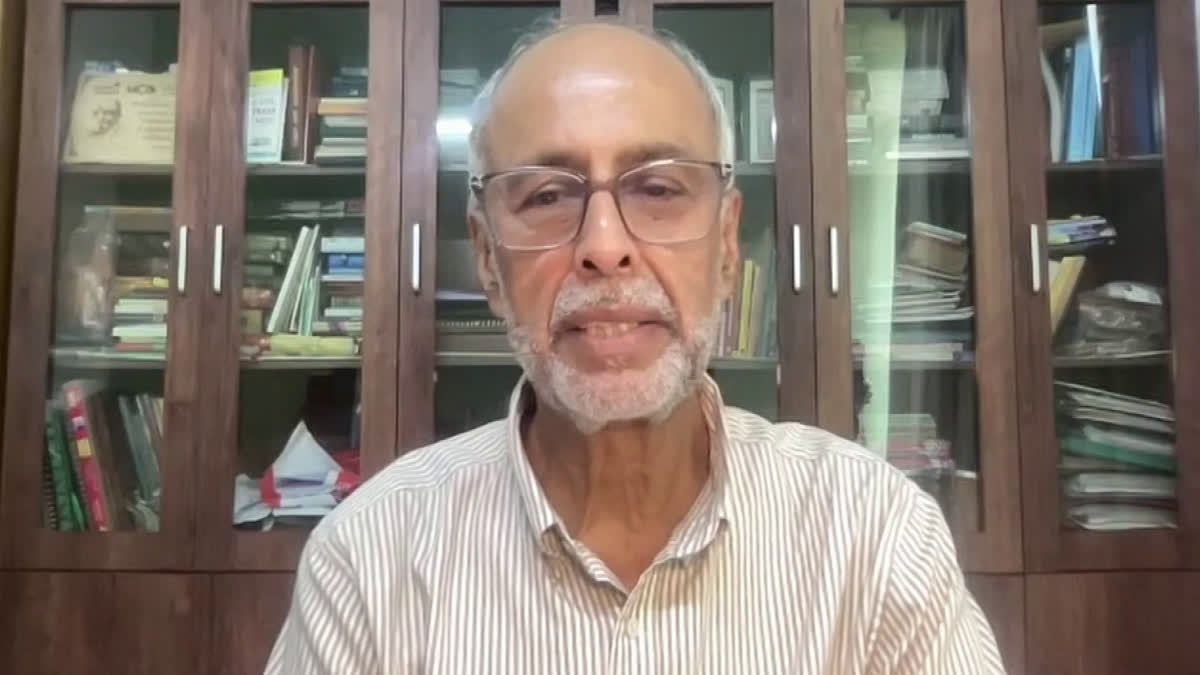New Delhi: While the monsoon season offers much-needed relief from the scorching heat, it also brings with it pressing challenges, like flooded streets, waterlogging and potholes. Every year, this problem causes significant disruptions to daily life also creating substantial safety risks, since overflowing drains and damaged roads frequently result in accidents and dangerous circumstances for both pedestrians and automobiles.
Former Secretary of the Ministry of Urban Development, Dr Sudhir Krishna, spoke to ETV Bharat's Surabhi Gupta in an exclusive interaction and discussed the complexities of managing water issues during the monsoon season.
Dr Krishna highlighted that many urban areas have evolved from small villages to bustling cities over the past few decades. This transformation has significantly altered the natural water flow patterns. Previously, water would naturally flow through ponds and minor streams, but urban expansion has overwhelmed these natural channels with real estate developments. Consequently, the fundamental drainage systems have been compromised.
Dr Krishna pointed out that natural drainage channels are now obstructed, preventing rainwater from reaching lakes and ponds, saying, “Rainwater that was supposed to flow to water bodies like lakes and ponds is not able to reach there, thus lakes are drying up, and some people see it only as an open space. So they are now using such lands, either by encroaching on them or by building slums or even government projects are coming up there.”
The former Secretary emphasised the urgent need to restore natural drainage systems. He suggested that one effective approach would be to use satellite imagery to map out existing drainage networks and identify necessary reconstructions. By accurately delineating these networks, cities can better manage water flow and prevent future flooding.
To prevent further damage, Dr. Krishna also proposed that cities should adopt a geographical model to determine the appropriate water levels for reservoirs and ensure that they are protected under municipal regulations. He said, “The full tank level (FTL) has to be determined, and a geographical (GIS) model can be constructed to determine the inundation area when it rains so much, and the lands that would come under the FTL inundation zone, should be protected and notified under the Master Plan, Building Bye-Laws and Municipal and other relevant laws to regulate the development of such lands.
A critical issue that Dr. Krishna addressed was the deterioration of man-made drainage systems. He explained that, historically, roadside drains were open and allowed for easy maintenance and cleaning. However, as roads widened and infrastructure evolved over the past 3-4 decades, these drains were covered and narrowed, reducing their capacity and making them more prone to blockages. The inadequate design and maintenance of these engineered drains have led to frequent road flooding, even with relatively minor rainfall.
According to Dr Krishna, the poor management of drainage systems is a main source of road flooding. Flooded roads quickly develop potholes, which deteriorate over time and lead to serious inconvenience to the road users, besides accidents.
Another key point Krishna raised was the fragmented responsibility for road and drainage maintenance. In many cities, multiple agencies, including national and state highway authorities, municipalities, and development bodies, are involved in managing different segments of the road infrastructure. This fragmentation often leads to a lack of coordinated effort in maintaining and cleaning the drainage systems. According to him, “There are around 30 organisations owning the roads in the NCT of Delhi. For so many departments to sit together and work out a coordinated strategy to ensure properly aligned actions for the maintenance of the drains is quite a difficult proposition.
Dr. Krishna concluded his discussion by advocating for improved urban planning and management. He proposed several measures to address the drainage issues, including the recycling and reusing of rainwater to recharge soil and reduce overall water consumption. Additionally, making engineered drains permeable through better construction materials and integrating rainwater harvesting pits could further alleviate flooding and support sustainable urban water management.
As cities continue to expand and face the annual challenges of the monsoon season, Dr. Krishna's recommendations offer a roadmap for improving urban drainage systems and mitigating the impact of heavy rains. By restoring natural drainage channels, improving infrastructure design, and fostering better coordination among agencies, cities can better manage the effects of the monsoon and create a safer and more resilient urban environment.



